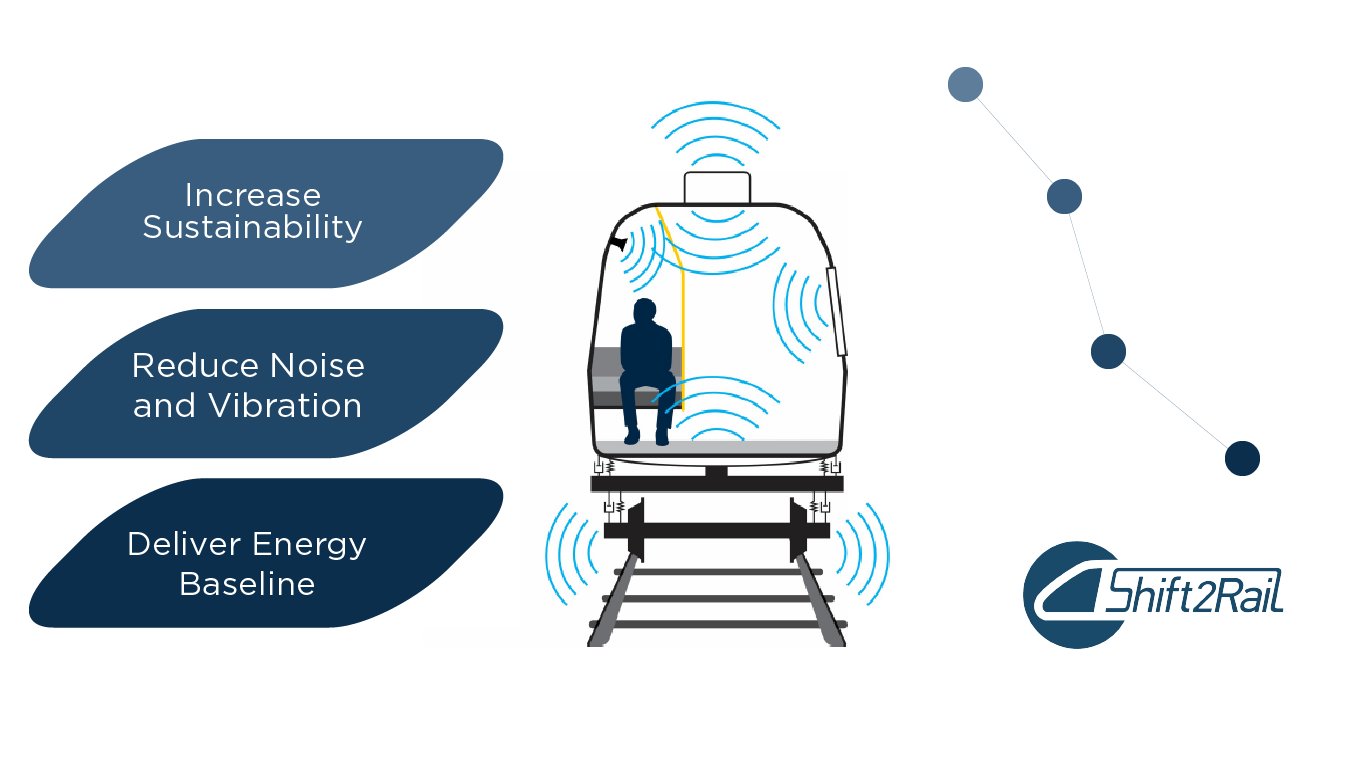Europe must take decisive steps to simplify and modernise its rail systems to strengthen competitiveness,...

Main Benefits
- Deliver a commonly agreed energy baseline for the four Shift2Rail system platform demonstrators (high speed, regional, urban-metro and freight application) and a modelling tool to evaluate, improve and optimise the energy consumption of rail systems with a particular focus on rolling stock.
- Develop future methods for predicting overall noise and vibration performance on a system level including both rolling stock, infrastructure and its environment.
- Assess and advise all energy related works as well as noise and vibration aspects which are considered and integrated in all relevant Technology Demonstrators across the Innovation Programmes of Shift2Rail.
Shift2Rail is working to increase the sustainability benefit of rail by reducing both the energy consumed and the noise emitted from railways. For noise, an auralisation and visualisation tool is being developed which enables the inclusion of human perception in the assessment of different noise mitigation scenarios when building or upgrading a railway line. On the energy front, an eco-labelling methodology has been proposed that could provide a good basis for the sector for moving forward. As an outcome of the first projects, that at component level there are significant energy reductions achieved by the different S2R technologies, overall at system level, they can reach an energy savings of around 4 – 8%, depending on the SPD.
The Challenge
When introducing new technologies at the component level and in different technology demonstrators, the system approach is important because the performance of all the systems acting together may give other priorities than considering only one isolated part of the system. To implement this systems approach, the work conducted within Shift2Rail’s five Innovation Programmes is supported by cross cutting themes proposing harmonised methods and tools that are of relevance to several of the Technology Demonstrators across Shift2Rail.
One of the working areas of Shift2Rail concerns Energy and Sustainability. Energy efficiency simultaneously enables improvement of railway’s excellent environmental balance by cutting down CO2 emissions and improves the economic business model of the Railway Transport sector by reducing the cost of energy, making train travel more affordable and thus promoting the modal shift to rail.
Noise and Vibration represent one of the biggest environmental challenges for railway. A pleasant and comfortable journey for passengers and the mitigation of noise annoyance for people living nearby rail infrastructure are fundamental. Due to this, an effective noise and vibration management is crucial.
The Solution
Through a culmination of several different projects funded through Shift2Rail, work on the area of energy, noise, and vibration reduction contributes to the Joint Undertaking’s ambitious energy and environment goals. The collaboration between several projects working on energy and sustainability highlights the matchmaking and capacity-building structure of Shift2Rail.
The first, tangible results from ongoing projects show significant energy saving potentials when introducing the S2R technologies. The use of SiC components in the traction system can achieve a 15% energy reduction at train level for regional application. The introduction of smart energy metering contributes to energy saving up to 20% of the energy bill depending on the use case. New hybrid propulsion system can bring at least 10% fuel consumption reduction thanks to energy recuperation by batteries.
As demonstrated above, environmental and energy concerns touch all parts of the rail system, and solutions cannot be limited to one pillar of operation. Reducing energy consumption is also linked to reducing system cost and the role of the CCA activities are essential for harmonisation. An improved energy calculation methodology and an energy simulation tool is developed within the programme which considers the four Shift2Rail System Platform Demonstrators. The work area also contributed to energy standards such as EN 50591. These standards were selected as the key reference for evaluation of energy consumption related to eco-labelling.
In order to achieve progress on noise and vibration in the European railway system, a commonly agreed and validated simulation tools is being developed to correctly quantify and rank the noise and vibration sources before deciding on costly measures for their mitigation. A modular framework for interior noise management including methodologies for source and transmission analysis and an evaluation tool for analysis of technical and economic impact of noise mitigation measures will be achieved by end of this year.
With regards to the concrete technology developments, the technical improvements taken in the running gear 5L (low-noise, lightweight, long running, logistic capable, LCC-oriented) concept reduces the force ratios in the wheel-rail contact, which results in reduction of unpleasant squealing noise. First test results show that the prototype of noise damping mechanical absorption solutions have an overall reduction of 6 dB, reaching up to 12 dB in the third octave band, with the most critical frequencies.
The auralisation and visualisation tool could enable easy demonstrations of the benefit of the noise mitigation technologies such as the ones mentioned above.
Taken together, the Shift2Rail innovations put forward on reducing energy consumption, as well as noise and vibration externalities in the rail system, increase attractiveness and contribute to achieving a zero carbon and silent rail system while reducing costs.
















